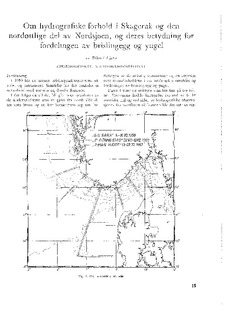| dc.contributor.author | Ljøen, Rikard | |
| dc.date.accessioned | 2011-06-08T12:38:41Z | |
| dc.date.available | 2011-06-08T12:38:41Z | |
| dc.date.issued | 1962 | |
| dc.identifier.issn | 0071-5638 | |
| dc.identifier.uri | http://hdl.handle.net/11250/113833 | |
| dc.description.abstract | Since 1959 the Norwegian sprat investigations have been considerably intensified. In this connection extensive hydrographical investigations have also been carried out. In this paper an account is given of the distribution and movement of the different water masses in the area shown in Fig. 1. The distribution of sprat eggs and larvae in relation to the hydrographical conditions has also been discussed. A warm surface layer with high content of oxygen, and a low phosphate content was separated from the underlying water masses by a transition layer in which the stability was particularly high. A core of Atlantic water with relatively high salinity, temperature and oxygen content, and a low content of phosphate, penetrated into the Skagerak along the edge of the North Sea Plateau, continuing along the Swedish and Norwegian coasts, constantly losing its original character (Fig.s 2 and 3). Current measurements were made at an anchor station (St. 410 on Fig.s G and 7). During the summers of 1960 and 1961 drift-bottle-experiments were carried out. The assumed drift is shown in Fig.s 8 and 9. The number of days drift is indicated at the point of recovery. The investigations indicate the existence of a cyclonic vortex in Skagerak. Persuming dynamic equilibrium this vortex is in good accordance with the depth of the boundary surface between the upper layers and the deep-water masses found by Dietrich ( 1950). Sprat eggs and larvae were collected in vertical hauls with a one-meter egg net. Examples of their distribution in the area are given in Fig.s 10 and 11. During the last 10 years sprat larvae have been caught in much smaller numbers outside western Norway than one might expect in relation to the concentration of eggs and larvae in Skagerak. The present author is of the opinion that because of the cyclonic vortex mentioned above, the larvae are forced to remain in the Skagerak for a relatively long period. When they finally are carried to the area off western Norway, they have grown large enough to avoid the plankton nets used. | en_US |
| dc.language.iso | nob | en_US |
| dc.publisher | Havforskningsinstituttet | en_US |
| dc.relation.ispartofseries | Fisken og havet;1962 - Nr. 1 | |
| dc.subject | sprat | en_US |
| dc.subject | brisling | en_US |
| dc.subject | hydrography | en_US |
| dc.subject | hydrografi | en_US |
| dc.subject | juveniles | en_US |
| dc.subject | yngel | en_US |
| dc.title | Om hydrografiske forhold i Skagerak og den nordøstlige del av Nordsjøen, og deres betydning for fordelingen av brislingegg og yngel | en_US |
| dc.type | Journal article | en_US |
| dc.subject.nsi | VDP::Agriculture and fishery disciplines: 900::Fisheries science: 920::Resource biology: 921 | en_US |
| dc.subject.nsi | VDP::Mathematics and natural science: 400::Geosciences: 450::Oceanography: 452 | en_US |
| dc.source.pagenumber | 9 s. | en_US |
